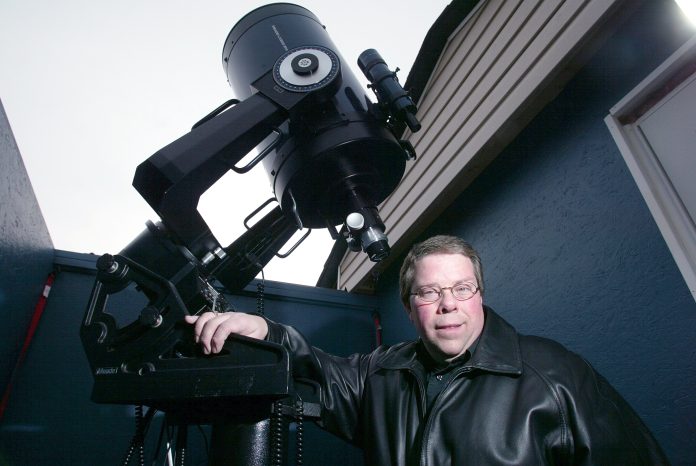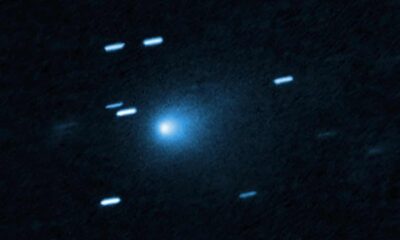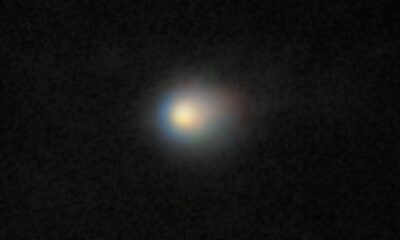Science
Interstellar Visitor Raises Questions as It Approaches Earth

A mysterious interstellar object named 3I Atlas is drawing attention as it approaches Earth, with its trajectory linked to the WOW signal, a notable radio burst detected in 1977. Astronomers, including educator Gary Boyle, are closely monitoring this unprecedented phenomenon, which has raised questions about its unusual behavior compared to typical comets.
Boyle, a former president of the Royal Astronomical Society of Canada Ottawa Centre, described Atlas as an object unlike anything seen in modern astronomy. He noted that its path appears to originate from the direction of the Milky Way’s Sagittarius constellation, which is particularly intriguing given its proximity to the area associated with the WOW signal. “Where 3I Atlas seems to be coming from was within about nine degrees of that area,” Boyle explained.
Initially classified as a comet, Atlas began displaying characteristics that defy conventional categorization. Boyle highlighted that it exhibited an anti-tail, which points away from the Sun, a phenomenon observed in rare comets under specific conditions. However, Atlas presented an even stranger behavior: it had only an anti-tail for the first couple of months with no typical tail formation. He remarked, “That’s another question mark on what this thing really is.”
As Atlas approaches the Sun, additional anomalies have emerged. Boyle observed that the object’s color has changed multiple times and that astronomers detected seven jets emanating from it, suggesting possible outgassing. “Could these jets be thrusters like we have in our spacecraft?” he pondered. The most perplexing characteristic is its non-gravitational acceleration; rather than slowing down after passing the Sun, Atlas is actually speeding up. “Natural comets sometimes show small deviations because of gas jets, but the scale of the behavior is raising eyebrows,” Boyle stated.
The interstellar visitor is expected to come closest to Earth on December 19, 2023, at a distance of approximately 400 million kilometers. This distance is safe but close enough to provoke further inquiry. Boyle remarked, “It has already passed Venus, Mars, and Jupiter within tens of millions of kilometers. Why is it passing planets in the solar system just like we have passed our planets with earlier spacecraft?”
Despite the excitement, no major observatory has yet provided a high-resolution image of Atlas, leading to a growing debate within the scientific community. Observations from the Mars Reconnaissance Orbiter captured details of the object on October 2 and 3, but due to a recent government shutdown in the United States, the data has not yet been released. “The scientific community is waiting to see those clear pictures,” Boyle explained, expressing frustration over the lack of transparency. He likened the situation to a patient being denied crucial information by a doctor.
This lack of access has sparked discussions, particularly from prominent figures like Avi Loeb, a Harvard astrophysicist who has been vocal in urging NASA to disclose the images. Loeb posits that Atlas could potentially be a probe or vehicle rather than a natural celestial object. Boyle noted that this perspective is not isolated, as other scientists share similar sentiments. Conversely, British physicist Brian Cox has dismissed the idea of alien technology, emphasizing the need to rely on empirical data.
“There was that squabble coming back and forth,” Boyle remarked. He believes the discourse reflects a broader uncertainty regarding humanity’s understanding of interstellar visitors. When asked about the possibility of alien technology behind Atlas, Boyle hesitated but did not dismiss it outright. “Alien technology could be underlying,” he said, cautioning that extraterrestrial life might not conform to human expectations. He referenced Carl Sagan’s analogy of Flatland, suggesting that advanced civilizations could operate in dimensions that remain imperceptible to humans.
As public interest in Atlas grows, particularly among amateur astronomers in places like Saskatchewan, Boyle acknowledged the importance of fostering curiosity about the cosmos. The province’s dark skies make it a prime location for stargazing, and recent displays of the Northern Lights have only heightened this interest. “If we can get more people interested in sciences such as this, who knows what that could lead to?” he posited.
Looking ahead, all eyes are now on NASA for the anticipated release of the previously captured images. These visuals could potentially clarify the object’s peculiar behavior or introduce new questions altogether. “Stay tuned,” Boyle advised. “This might be real.” As 3I Atlas continues its journey back into deep space, the scientific community remains poised to unravel the mysteries it leaves in its wake. As Boyle succinctly put it, “Of 400 billion stars in the Milky Way, there must be life somewhere. It’s really hard to argue we are the only ones.”
-

 Politics1 week ago
Politics1 week agoSecwepemc First Nation Seeks Aboriginal Title Over Kamloops Area
-

 World4 months ago
World4 months agoScientists Unearth Ancient Antarctic Ice to Unlock Climate Secrets
-

 Entertainment4 months ago
Entertainment4 months agoTrump and McCormick to Announce $70 Billion Energy Investments
-

 Lifestyle4 months ago
Lifestyle4 months agoTransLink Launches Food Truck Program to Boost Revenue in Vancouver
-

 Science4 months ago
Science4 months agoFour Astronauts Return to Earth After International Space Station Mission
-

 Technology3 months ago
Technology3 months agoApple Notes Enhances Functionality with Markdown Support in macOS 26
-

 Top Stories1 month ago
Top Stories1 month agoUrgent Update: Fatal Crash on Highway 99 Claims Life of Pitt Meadows Man
-

 Sports4 months ago
Sports4 months agoSearch Underway for Missing Hunter Amid Hokkaido Bear Emergency
-

 Politics3 months ago
Politics3 months agoUkrainian Tennis Star Elina Svitolina Faces Death Threats Online
-

 Politics4 months ago
Politics4 months agoCarney Engages First Nations Leaders at Development Law Summit
-

 Technology4 months ago
Technology4 months agoFrosthaven Launches Early Access on July 31, 2025
-

 Top Stories3 weeks ago
Top Stories3 weeks agoFamily Remembers Beverley Rowbotham 25 Years After Murder













